Type
3 Aerodynamics...
or "How To Keep Your Type 3 from Flying"
There has been some recent discussion about
the aerodynamic differences between the various Type 3 body styles.
I thought I would try to do a little research on the subject and get a
bit of information out there. In case your wondering, I have a bachelor's
degree in aeronautical engineering, so hopefully that lends a bit of credence
to what you are about to see. I should also remind you that rossed
over to the DARKSIDE. Yes, that's right, you will see some mention
of ground effects and spoilers and wings and such things. The DARKSIDE
has a strong pull.
The
Basics
There are two basic aerodynamic force
at work on your T3, LIFT and DRAG. LIFT is the force trying to make
your car fly, to lift it off the ground. DRAG is the force imparted
by the air on your car that is trying to keep it from moving forward, or
backwards if you are in reverse. These are shown schematically here.
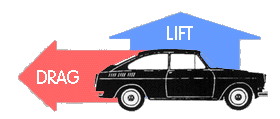
Both LIFT and DRAG are typically characterized
by a non-dimensional coefficient CL and CD respectively.
CL does not get much press since it is really only a factor
at very high speeds and then only if it affects the car negatively, particularly
in crosswind situations. The car companies are pretty good about
making sure this does not happen. Of course, CL is also
evident in race cars, but it is called "downforce" which is really just
negative lift. CD on the other hand gets quite a bit of
press since it is tied directly to fuel economy. CD is
often advertised by car companies.
So where does the T3 stand relative to
other cars? I did a little digging and actually found some test data
specific to T3's. It turns out VW did a bunch of wind tunnel benchmarking
with a Notchback! I have tabulated some CD and CL
values for the T3 and for some other cars.
|
Vehicle
|
CL
|
CD
|
Frontal Area
(meters^2)
|
|
Early VW Notchback
|
0.38
|
0.34
|
-
|
|
VW Beetle
|
-
|
0.49
|
1.80
|
|
VW Golf GTI
|
-
|
0.35
|
1.91
|
|
Porsche 911 Carrera Cabrio
|
-
|
0.40
|
1.77
|
|
Mazda RX-7
|
-
|
0.37
|
1.69
|
|
Honda Civic
|
-
|
0.38
|
1.72
|
|
73 Opel Record
|
0.36
|
0.47
|
-
|
|
80 Peugeot 305 GL
|
0.44
|
0.44
|
1.84
|
|
86 Subaru XT
|
0.10
|
0.30
|
-
|
So,
what about the T3 specifically?
Unfortunately I do not have data that
directly compares the Notch, Fasty, and Square, but I have included some
additional data and information below and made an estimate of CL
and CD for the three different body styles.
The biggest difference between the three
body styles is obviously the shape of the rear end above the fender trim
line and rearward of the b-pillar. The important aerodynamic characteristic
for this area is the rake angle, A, of the rear surface. This is
measured from a line parallel with the horizon as shown in the table below.
However, the shape of the rear edge of the roof has some influence on this
aerodynamically. If the roof edge is sharp, the aerodynamic rake
angle is equivalent to the geometric rake angle. However, in the
case of the T3, the rear roof edge is well rounded, thus effectively reducing
the rake angle. I have estimated the influence of the rear roof edge
in the table below.
|
Body Style
|
Rear Window
Rake Angle, A (degrees)
|
Aerodynamic
Rake Angle, B (degrees)
|
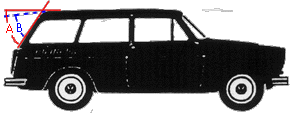
|
59
|
53
|
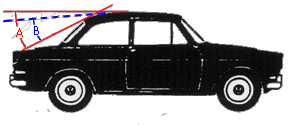
|
28
|
21
|
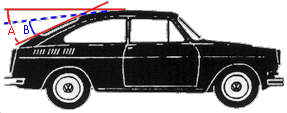
|
25
|
15
|
| So, how does this rake angle influence
the CD and CL of the T3? The graph to the right
shows the effect. VW did a good job staying away from the 30 degree
rake angle that results in the highest drag. While the chart is for
CD, the drag changes are mostly due to changes in the vortexes
generated at the rear of the vehicle and these vortexes influence CL
in a very similar manner. With LIFT comes DRAG.
So using the chart and the baseline data
for the Notchback that is tabulated above, the CD and CL
for the Fasty and Square can be estimated.
CD
CL
Notch
0.34 0.38
Fasty
0.32 0.36
Square
0.37 0.41 |
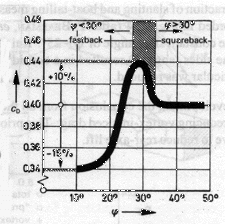 |
Based on these estimates the T3 is actually
pretty good aerodynamically, even compared to much more modern cars.
Why? Well, there are few design features of the T3 that potentially
contribute to lowering CD beyond the basic shape. The
lack of excessive details like chrome trim and such (compared to other
cars of the era) and the generally rounded edges of the body help.
The relatively flat bottom of the T3 also helps lower both CD
and CL by smoothing the airflow under the car. The air-cooling
of the engine reduces CD in a couple of ways. The lack
of a radiator opening in the front helps. The pulling of cooling
air from relatively high pressure areas of the rear of the car also helps.
It reduces the high pressure zones, thus reducing the lift in these areas
and subsequently the CL and CD. I suspect that
puling some of the high pressure air out of these areas also keeps the
airflow from separating until further back on the car thus reducing the
size of the turbulent wake behind the car which reduces CD.
The exhausting of the cooling air under the rear of the car also potentially
reduces the size of the turbulent wake behind the car.
VW did a pretty good job with the T3 aerodynamically.
Of course, I have come to expect nothing less.
So
what can the DARKSIDER do to improve a good thing....
As good as the T3 is aerodynamically,
the DARKSIDER can never leave anything alone.....so here is some data and
a few suggestions for improving the aerodynamics of your T3.
I mentioned earlier that VW used a Notchback
for calibrating and comparing different wind tunnels. Well, they
also did some testing using a Notchback to determine the influence of front
and rear spoilers. The results are shown below.
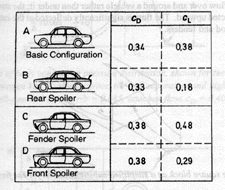 |
As you can see adding aerodynamic
devices such as spoilers can significantly influence the aerodynamic characteristics
of your DARKSIDE ride. Unfortunately, there were no details on exactly
where or how big the spoilers in the tests were. The decklid spoiler
is very effective at reducing lift since it will have a big influence on
the low pressure distribution at the rear of the vehicle and on the wake
behind the vehicle. The front air dam does not have as large an influence,
but it is significant. Neither affect the DRAG much. I am not exactly
sure what they are talking about with the fender spoiler, but it doesn't
look like it would be very desirable anyway. (higher DRAG and LIFT) |
As for the front airdam, I was able to
come up with some more details about this one. VW tested various
front airdams on a Brazilian 1600. Looks like it might be the SP2
from the profile or maybe the Brazilian T3 Fastback. Again, the front
air dam does not significantly reduce the DRAG and even increases it if
the spoiler get to deep. This is probably due to the increase in
frontal area of the car. It can, however, significantly reduce the
LIFT of the vehicle, particularly the lift on the front wheel. In
the case of the deepest angled spoiler, the reduction is more than half!
The inset figure (b) shows that DRAG is reduced as the spoiler gets deeper
(to a limit) and as it is moved forward on the vehicle.
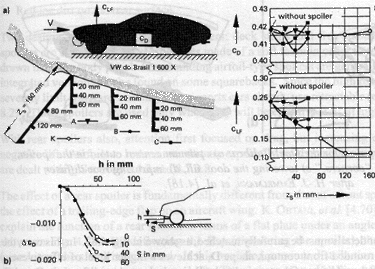
My
Recommendation...
Given the above information and including
the other information I have read, what would I recommend? One complaint
about the T3 that I here often is the wandering at high speeds in crosswinds.
This is due to the relatively light front end and the LIFT at the front
wheels. The simplest way to improve this would be to add a 100mm
or so front air dam as far forward on the car as possible. This will
reduce the lift on the front end while adding little or no DRAG.
Looking for better fuel economy of top end performance, I would add a small
spoiler on the rear of the car to reduce the turbulent wake behind the
car and thus the DRAG. It should also help to reduce the LIFT on
the car.
There are a few other things that you could
do and I might try a few of these. You could add a belly pan to the
underside to smooth out the underbody around the front beam and the engine
and trans. You could even incorporate a venturi and diffuser into
it to create a little downforce! Adding a lower rear valance will
help reduce the turbulent wake some and adding a deeper rocker (ground
effects) will help some too.
As I come up with ideas for my Fasty I
will add them here for all to see. I hope this has been informative
and helpful. If you have any specific ideas or questions, please
e-mail
me. I will be glad to discuss it.

|





